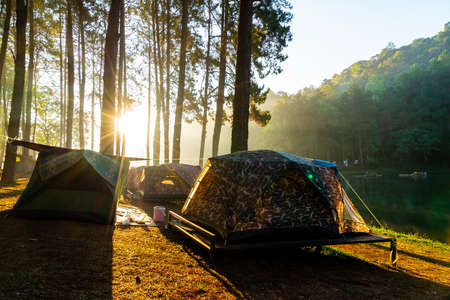1. Introduction to Eco-Friendly Car Camping
Car camping is one of America’s favorite ways to explore the great outdoors, from road-tripping through national parks to spending weekends at scenic campgrounds. But with more folks hitting the trails and setting up camp, it’s more important than ever to protect our wild spaces. Eco-friendly car camping means making choices that leave nature as untouched as possible while still having a blast outside.
Why Sustainable Car Camping Matters
Every year, millions of people visit forests, deserts, mountains, and lakes across the U.S. Without sustainable habits, those beautiful places can get trashed—literally. Trash left behind, damaged plants, polluted water, and noisy campsites all put stress on wildlife and ruin the experience for everyone else. Practicing eco-friendly car camping helps make sure our favorite spots stay wild and awesome for years to come.
Key Benefits of Eco-Friendly Car Camping
| Benefit | How It Helps |
|---|---|
| Protects Wildlife | Keeps animals safe from litter and human food |
| Saves Natural Resources | Reduces waste and conserves water & energy |
| Keeps Campsites Beautiful | Prevents pollution and overuse damage |
| Supports Public Lands | Shows respect for parks and public spaces |
| Sets an Example | Encourages others to camp responsibly |
The American Outdoor Experience: Why It Matters Here
The U.S. is famous for its national parks, vast forests, and open wilderness. Our outdoor spaces are a big part of American culture—think Yosemite, the Grand Canyon, or your local state park. When we camp sustainably, we’re helping protect these national treasures so future generations can fish, hike, and camp just like we do now. Eco-friendly car camping isn’t just a trend—it’s how real outdoor lovers show respect for America’s wild places.
2. Choosing Green Gear and Supplies
Why Your Gear Choices Matter
When it comes to eco-friendly car camping, what you pack is just as important as where you camp. The right gear can minimize your impact on the environment, save money in the long run, and make your outdoor experience smoother. Let’s break down how to pick sustainable equipment and supplies for your next adventure.
Tips for Selecting Eco-Friendly Equipment
- Go for Durability: Invest in high-quality gear that will last for years instead of single-use or flimsy items that end up in the landfill.
- Choose Recycled Materials: Many brands now offer tents, sleeping bags, and backpacks made from recycled plastics or natural fibers.
- Avoid Harmful Chemicals: Look for products free from PFCs, PVC, and other toxic coatings that can leach into nature.
- Support Local Brands: Buying locally-made gear reduces shipping emissions and supports small businesses in your area.
Reusable Gear Essentials for Car Campers
| Item | Eco-Friendly Alternative | Why It’s Better |
|---|---|---|
| Water Bottles | Stainless steel or BPA-free reusable bottles | Cuts down on single-use plastic waste |
| Cooking Gear | Titanium or cast iron cookware | Long-lasting and non-toxic materials |
| Dishes & Utensils | Bamboo or metal sets | No more disposable plates and cutlery piling up at campsites |
| Food Storage | Silicone or beeswax wraps, reusable containers | Keeps food fresh without plastic bags or wrap |
| Lamps & Lanterns | Rechargeable LED lights or solar-powered lanterns | Saves batteries and reduces waste on longer trips |
Sustainable Products Tailored for Car Camping
- Biodegradable Soap: Always wash dishes and yourself at least 200 feet from water sources using biodegradable soap to protect streams and lakes.
- Eco-Friendly Fire Starters: Use recycled paper, pine cones, or store-bought eco-fire starters instead of lighter fluid or chemical-soaked cubes.
- Solar Chargers: Power up phones, GPS units, or headlamps with compact solar panels—perfect for off-grid locations.
- Packed-Out Trash Bags: Bring strong reusable trash bags for all your waste—leave no trace means packing out everything you brought in.
- No-Trace Toilet Solutions: Consider a portable toilet system with compostable bags if there are no facilities nearby; always follow local rules about waste disposal.
Your Green Checklist: What to Ask Before You Buy
- Is it reusable or recyclable?
- Was it made ethically or locally?
- Does it contain recycled content?
- Is it built to last through multiple seasons?
- Will it help me reduce my trash footprint?
The best part? Making thoughtful choices now means less hassle (and less waste) on every future camping trip. So next time you gear up for an adventure, keep sustainability top of mind—you’ll be making a real difference out there!

3. Low Impact Campsite Setup
Choosing the Right Campsite
When car camping with eco-friendly intentions, where you set up camp matters just as much as what you pack. The goal is to leave nature exactly as you found it—or even better. Here’s how to pick a spot that keeps your footprint as light as possible:
| Do | Don’t |
|---|---|
| Use established campsites or existing clearings | Create new fire rings, trails, or campsites in untouched areas |
| Camp at least 200 feet from water sources (like lakes and streams) | Set up right on riverbanks or lakeshores, which can damage fragile ecosystems |
| Look for durable surfaces: gravel, sand, dry grass, or hard-packed soil | Pitch your tent on living plants, moss, or soft meadows |
| Check for signs of wildlife activity and choose a spot away from animal trails or burrows | Disturb animal homes or block their natural paths |
Setting Up Your Camp Like a Pro
Tent Placement and Gear Organization
- Minimize the area you use: Keep your tent, chairs, and cooking zone close together to reduce impact.
- Avoid trenching: Don’t dig ditches around your tent; modern tents are waterproof enough without them.
- Skip hanging items on trees: Use free-standing racks for gear instead of tying ropes to branches, which can damage bark.
- Pack it in, pack it out: Bring reusable containers for food and trash so nothing gets left behind.
Campfire Considerations (If Allowed)
- Use designated fire rings: Only build fires in existing fire pits if local rules allow it.
- Try a camp stove: For cooking, portable stoves are cleaner and safer than open fires—no scar left behind.
- No gathering wood: Bring your own firewood if fires are permitted; don’t strip branches or collect wood from the forest floor.
Sustainable Habits Around Camp
- Loud is out: Keep noise low to respect both wildlife and fellow campers.
- Lights down: Use headlamps or lanterns with a red-light mode to minimize light pollution at night.
- Campsite check: Before you leave, do a sweep for micro-trash like twist ties or bread tags that could harm animals.
Your Eco-Friendly Car Camping Checklist:
| Sustainable Gear & Habits |
|---|
| Biodegradable soap and sponges for dishwashing away from water sources |
| No-trace trash bags for all waste (including food scraps) |
| Solar-powered lights and chargers instead of gas lanterns/generators |
| Reusable utensils, plates, and water bottles—ditch disposables! |
If everyone sets up camp this way, our wild places will stay wild—so you can keep coming back year after year for more adventures.
4. Responsible Waste Management
Pack It In, Pack It Out: Trash Strategies
When car camping, always plan to take all your trash with you. Bring heavy-duty trash bags and keep them in your vehicle. Don’t leave wrappers, cans, or plastic behind—animals can get into them, and they won’t break down anytime soon. Use the table below as a quick reference for packing out different types of waste:
| Type of Waste | How to Pack Out | Pro Tips |
|---|---|---|
| Food Wrappers & Packaging | Seal in a sturdy trash bag | Double-bag smelly items to avoid attracting wildlife |
| Cans & Bottles | Rinse and crush before storing | Use reusable containers whenever possible |
| Leftover Food Scraps | Store in airtight bag or container | Avoid dumping food scraps at your site—pack everything out! |
| Papers & Cardboard | Flatten for easy transport | Recycle when you get back to town if possible |
Managing Food Waste Like a Pro
Food waste attracts critters and can harm local wildlife. Keep it locked up in your car overnight or use bear-proof containers if you’re in bear country. Instead of tossing leftovers on the ground, pack every bit out—even biodegradable peels and coffee grounds. If you’re prepping meals ahead of time, try to peel and portion at home so you generate less waste at camp.
Quick Tips for Zero-Food-Waste Camping:
- Meal Prep Smart: Chop veggies and portion snacks at home.
- Airtight Storage: Use leak-proof containers for scraps.
- No Dumping: Never bury or toss food scraps, even if they seem harmless.
Handling Human Waste Responsibly
If your campsite doesn’t have toilets, it’s crucial to handle human waste the right way. The Leave No Trace rule is: if you pack it in, be ready to pack it out.
If Restrooms Are Available:
- Always use designated bathrooms or vault toilets.
- If theyre closed or full, move on to the next option—don’t go off-trail.
If No Facilities Are Available:
- Catholes: Dig a hole 6-8 inches deep and at least 200 feet from water sources, trails, or campsites. Cover it well after use.
- WAG Bags or Portable Toilets: In some areas (like deserts or popular sites), you must pack out your waste using portable toilet bags (“WAG Bags”) or a camp toilet system. Check local regulations!
- Packing Out Toilet Paper: Always bring a sealable bag for used TP and hygiene products—never leave them behind or burn them.
5. Leave No Trace Essentials
Understanding the Seven Principles for Car Camping
When it comes to eco-friendly car camping, following the Leave No Trace (LNT) principles is key to protecting America’s wild places. These seven principles are a practical guide for making sure your outdoor adventures don’t leave a mark. Here’s how you can apply each one specifically during your car camping trips:
| Principle | Car Camping Tips |
|---|---|
| 1. Plan Ahead and Prepare | Check local regulations, weather, and campsite info before heading out. Pack reusable gear and bring only what you need to minimize waste. |
| 2. Travel and Camp on Durable Surfaces | Park your vehicle in designated areas or established sites. Avoid driving or setting up camp on fragile vegetation or soft soil. |
| 3. Dispose of Waste Properly | Pack out all trash, leftover food, and litter—even micro-trash like bottle caps or twist ties. Use campground facilities for trash and recycling when available. |
| 4. Leave What You Find | Don’t pick plants, collect rocks, or disturb historical artifacts. Take photos instead of souvenirs to remember your trip. |
| 5. Minimize Campfire Impact | If fires are allowed, use established fire rings and keep fires small. Better yet, use a camp stove for cooking to reduce impact. |
| 6. Respect Wildlife | Observe animals from a distance and never feed them. Store food securely in your car or bear-proof containers to avoid attracting wildlife to your campsite. |
| 7. Be Considerate of Other Visitors | Keep noise down—especially at night—and respect other campers’ space and privacy. Yield trails to hikers and follow posted quiet hours. |
Making Leave No Trace Second Nature While Car Camping
The best way to make Leave No Trace work is to build these habits into every part of your trip, from planning all the way through packing up camp. Whether you’re road-tripping through national parks or camping at a local state forest, practicing these essentials helps keep our public lands wild and open for everyone.
6. Eco-Conscious Activities
Car camping is all about enjoying the outdoors, but it’s even better when your activities respect and protect nature. There are plenty of fun ways to stay entertained while being eco-friendly and following Leave No Trace principles. Here are some ideas that blend outdoor adventure with environmental awareness.
Wildlife Viewing
Observing wildlife is a classic car camping activity, but it’s important to do it responsibly. Always keep a safe distance from animals, use binoculars or a camera with a zoom lens, and never feed wild creatures. Early mornings or dusk are the best times for spotting animals in their natural habitat. Remember, you’re a guest in their home—move quietly and leave no trace behind.
Wildlife Watching Tips
| What to Do | How It Helps Nature |
|---|---|
| Keep Quiet & Move Slowly | Avoids startling wildlife and minimizes stress on animals |
| Use Binoculars | Allows close-up views without getting too close |
| Stay on Trails | Protects fragile habitats and prevents trampling vegetation |
| Pack Out All Trash | Keeps habitats clean and safe for animals |
Trail Stewardship
Giving back to the trails you love is a great way to make your car camping experience more sustainable. This could be as simple as picking up litter during your hike, or joining local trail maintenance days if available. Not only does this help preserve the land for future campers, but it’s also a meaningful way to connect with fellow outdoor enthusiasts.
Easy Ways to Give Back
- Packing out trash: Always bring a bag for any litter you find along the trail.
- Tread lightly: Stick to marked paths to avoid eroding new areas.
- Volunteer locally: Check with park rangers or trail groups for volunteer opportunities.
Low-Impact Recreation Ideas
You don’t need high-tech gear or big crowds to have fun outdoors. These low-impact activities let you enjoy nature while keeping your footprint light:
- Hiking and walking: Stick to existing trails and avoid shortcutting switchbacks.
- Paddle sports: If you’re near water, kayaking or canoeing can be peaceful and gentle on the environment—just rinse off gear before moving between lakes or rivers to prevent invasive species spread.
- Naturally-powered fun: Try stargazing, nature journaling, photography, yoga, or birdwatching—no batteries required!
- Campsite games: Bring cards or simple board games instead of noisy electronics.
Your Next Adventure Awaits—Leave Only Footprints!
7. Building a Culture of Stewardship
How to Inspire Fellow Campers
Creating a culture of stewardship starts with leading by example. When you show respect for the outdoors, others notice—and often follow suit. Whether youre camping solo or with friends, take the initiative to pick up trash, use reusable gear, and stick to marked trails. If you see someone doing something harmful, like leaving food out or washing dishes in a stream, kindly share what youve learned about eco-friendly car camping. You don’t have to preach; sometimes a simple “Hey, I’ve found this method works great for keeping campsites clean!” does the trick.
Sharing Green Habits at the Campsite
Sharing your eco-friendly habits can make a real difference, especially when camping with kids or new campers. Make it fun—challenge everyone to reduce waste or spot native plants and wildlife without disturbing them. Here’s a quick table showing easy ways to share green habits at camp:
| Habit | How to Share It |
|---|---|
| Pack Out Trash | Set up a “leave no trace” game: who can find and pack out the most micro-trash? |
| Use Reusable Gear | Show off your favorite reusable utensils and water bottles—swap tips on where to buy them. |
| Respect Wildlife | Remind everyone not to feed animals; point out why wild critters need space. |
| Eco-Friendly Cooking | Share recipes that use minimal packaging and leave little waste behind. |
Contributing to Conservation Efforts in America’s Wild Places
You don’t have to be a scientist or park ranger to help protect wild places. Small actions add up! Volunteer for local cleanups, donate to conservation groups, or join trail maintenance days organized by national parks or forest services. Even sharing posts on social media about Leave No Trace principles helps spread awareness. Here are some easy ways anyone can get involved:
- Join local “Adopt-a-Trail” programs
- Support organizations like The Leave No Trace Center for Outdoor Ethics or the National Park Foundation
- Report vandalism or pollution to rangers or park staff
- Take part in citizen science projects (like bird counts or invasive species tracking)
The Ripple Effect of Stewardship
Your actions matter more than you think. By fostering green habits at your campsite and encouraging others to do the same, you help protect America’s wild places for generations of campers and outdoor adventurers yet to come. Every positive action—no matter how small—helps build a stronger culture of stewardship among car campers across the country.


